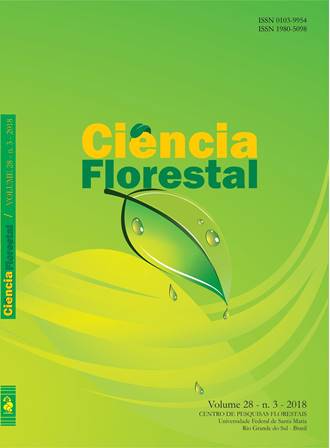INTENSIVE MANAGEMENT FOR OPTIMIZING THE PRODUCTION OF HIGH-VALUE LOGS OF PINE FORESTS IN SOUTHERN BRAZIL
DOI:
https://doi.org/10.5902/1980509832579Keywords:
growth and yield simulator, operational research, thinning regimes, planting density.Abstract
The best decision-making is a difficult task in forest management because it involves a large number of market and production variables. We simulated growth and yield of loblolly pine in high-quality sites, aiming to indicate thinning regimes and planting densities that maximize the production of large diameter logs (minor diameter >35 cm), as well as economically evaluating such regimes. We used the software OpTimber-LP for forest optimization problems. Simulations involved four planting densities (1,111; 1,600; 2,000; and 2,500 plants/ha); three thinnings with different weights, frequencies and ages of application; and clear cut at 25 years. Such combinations totalized in 2,916 simulated regimes. We calculated ANPV considering variations in interest rates, besides costs of production and returns resulting from thinnings and from clear cut. The findings indicated great productions of large diameter logs in regimes with low planting densities. Heavy thinnings (60% removal of trees) highlighted by being ideal to almost all thinnings, mainly in regimes with densities of 2,000 and 2,500 plants/ha. This intensity also was ideal to the first thinning, regardless the planting density. The most productive regimes presented large diameter log volumes ranging from 480 to 260 m³/ha, for regimes with 1,111 and 2,500 plants/ha, respectively. ANPV ranged from ~1.300 to ~2.100 R$/ha. As conclusion, less dense regimes provide largest productions in large diameter log, but lowest productions in total volume; as consequence, ANPV was larger in denser regimes, once the revenue obtained from high-value logs did not overcome that one obtained from finer (and consequently cheaper) logs. High-density regimes may produce less timber volume due to only one improper thinning, whereas low-density stands may have production really affected when are subjected to consecutive improper thinnings.
Downloads
References
GLÜCK, P. Der Beitrag der Forstwirtschaft zur Funktionsfähigkeit des ländlichen Raumes. In: WYTZRENS H. K. Funktionsfähigkeit des ländlichen Raumes. Wissenschaftsverlag: Vauk Kiel KG, 1999. p. 73-85.
IBAMA. Glossário - Serviços. Brasília: IBAMA, 2010. Disponível em: . Acesso em 2010.
INSTITUTO DO HOMEM E MEIO AMBIENTE DA AMAZÔNIA. [Web site]. Belém: IMAZON, 2008. Disponível em: <http://www.imazon.org.br/>. Acesso em 19 de Novembro de 2008.
LEBENSMINISTERIUM. Grüner Bericht. Viena: [s. n.], 2008. Disponível em: <http://www.grünerbericht/at>. Acesso em 23. de Outubro de 2008.
LENTINI, M.; VERISSIMO, A.; PEREIRA, D. A expansão madeireira na Amazônia. O Estado da Amazônia. [s. l. : s. n.], 2005. 4 p. Disponível em: <http://www.imazon.org.br>. Acesso em 19 de Novembro de 2008.
NIEUWENHUYSE, A. et al. Can Forestry be a competitive land use option? Model simulation from humid tropical Costa Rica. Forest Ecology and Management, Amsterdam, v. 137, p. 23-40, 2000.
RIO GRANDE DO SUL. Secretaria Estadual do Meio Ambiente. [Web site]. Porto Alegre: SEMA, 2008. Disponível em: <http://www.sema.rs.gov.br>. Acesso em 2008.
SAYER, J. A. Tropical forests: diverging development paradigms. Unasylva, [s. l.], v. 52, 2001.
SOCIEDADE BRASILEIRA DE SILVICULTURA. Fatos e números do Brasil florestal. [s. l.: s. n.], 2006. 109 p. Disponível em: <http://www.sbs.org.br>. Acesso 22 de Dezembro de 2006.
SMERALDI, R.; VERISSMO, A. Acertando o alvo: o consumo de madeira no mercado interno brasileiro e promoção da certificação florestal. São Paulo: Amigos da Terra, 1999. 41 p. Disponível em: <http://www.amazonia.org.br/meio2.htm>. Acesso em 16 de Novembro de 1999.
TOMASELLI, I. Forests and the future: regional perspective. Latin America and the Caribbean. Unasylva, [s. l.], v. 52, n. 204, p. 44-46, 2001.







